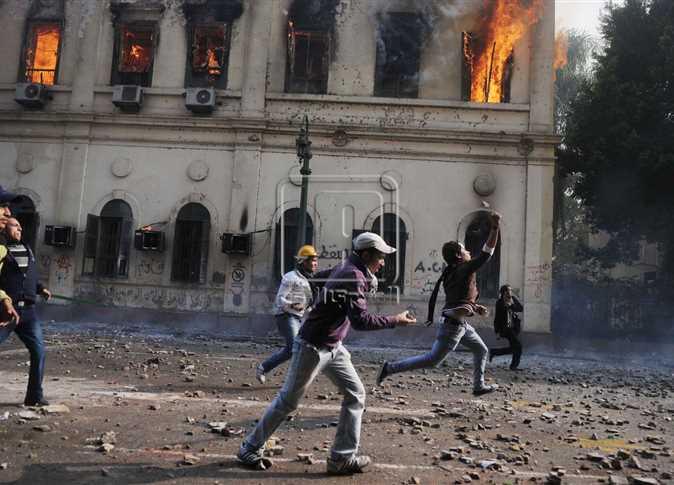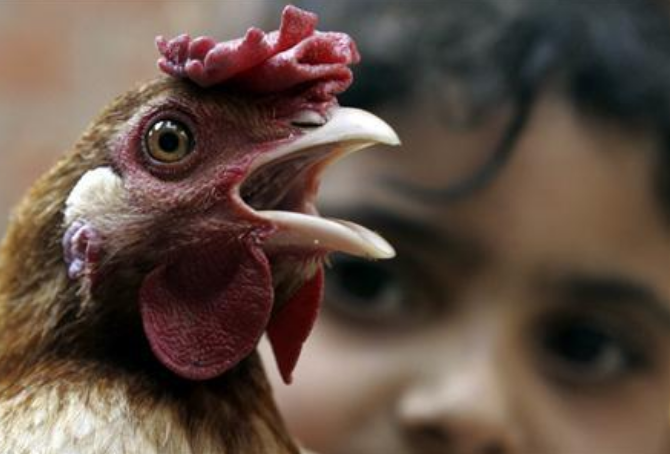Two Cairene galleries exhibited ruminations on revolutions in the environment, but the difference between the success of the two is obscene.
The French Cultural Center in Mounira hosts a marvelous show about the Egyptian uprising: “Field Statements: Images from Tahrir.” A group show, it comprises mostly photographic contributions, in addition to film pieces by a number of local artists. The “Revolutionary Vision” exhibition, at the recently established Art Bridge Cairo Gallery on Hoda Shaarawy Street, is much the same in terms of subject matter and media, but fails spectacularly.
The difference between the two exhibitions is perspective alone; the latter falls into the festering cesspool of patriotism and kitsch, and its vision of Egypt is anything but revolutionary. The images at Art Bridge Cairo depict this utterly tragic, constantly recreated set of archetypal and propagandist pictures of the country either ironically or by accident. I assume this is inadvertent. But it leaves an unfortunately bitter taste in the mouth of this reviewer. A photojournalist friend who attended the show said: “I look at this and I think me personally, or photography as a profession, is failing.”
The past few months of arbitrary arrests, military tribunals and violence have proven that it is far too early to celebrate 11 February as a triumphal resolution of the societal ills of the past decades. The photographs at Art Bridge Cairo represent this kind of national euphoria, but without making an intelligent comment or critique about the events in the aftermath of the 18-day uprising. Walking into the gallery the day after the attacks outside of Maspero, seeing a large print by artist Alaa Taher of an Egyptian flag sighing in the breeze, sun behind it, conveys a sense of the complete delusion so often encountered in the average discussion of politics in Egypt. As a result, the images seem presumptuous and foolish. These patriotic gestures – young man on shoulders of compatriot, striking his fist angrily at the injustice of Mubarak, silhouetted by the setting sun (also by Taher) seem gratuitous.
Tono Labra, another artist in the exhibit, created a series of photographs that one could only imagine to reappear one day on the Supreme Council of the Armed Forces’ Facebook page, titled “The Official State Revolution.” They will doubtlessly congratulate themselves for organizing such an uprising. Imagine digital photos turned black and white, and then resaturated with red. Emphasized in these images is the bold red stripe of the Egyptian flag, catchy protest slogans on the walls and heart-wrenching phrases on signs held by women in niqabs. The images are reminiscent of Kodak at its most commercial; the advertising of family memories. Even more disconcerting, the pictures are labeled chronologically marking days of the revolution, suggesting some sort of attempt to archive history in this work.
The highlight of this exhibition was the odd work of photographer Joachim Eckl. Whether due to an issue of translation or an acerbic sense of humor of the artist, unimaginative photos are paired with the most hilarious titles imaginable. All of these titles suggest propaganda, yet the images stand disconcertingly beside them. “Child Soldier – Fighting for a Better Future” is a close-up of a boy wearing an olive green army uniform. “Patriotic Family – Seeing the Light” is an image of a family of four standing against a tank, befuddled smiles on the upturned faces of mother and father, daughter looking utterly confused, son staring vapidly out of the frame. Most likely because of the quality of the image and the sharpening effects of many of the average digital cameras on the market, a faint white light caresses the folds of the mother’s hijab and the crown of her husband’s skull.
“Field Statements: Images from Tahrir” was something altogether different. Khaled Hafez, director of the film component of the exhibition, writes in the artist’s statement: “The … problem was how to obtain video and sound impressions from the creators … while ensuring not only that they were artistically viable but that they did not fall into the trap of realist cliches or endless deja vu footage already broadcast on the cable networks.” This measured consideration is evident. Rather than simply regurgitating hackneyed representations of the revolution, artists Marwa Adel, Hala Abu Shady, Yousry Bassem, Ahmed Sabry and Ahmed al-Shaer create different representations that have character. There were a number of strong contributions in this show, but a few remained standouts. The work of Shaer was absolutely brilliant, evoking the typical teenage (and unfortunately man-in-mid-20s) mindscape. In one piece, a portrait of Gamal Abdel Nasser surveys the expanse of a video game wasteland. Small, pixelated crab monsters fill the black negative space. Three zeros (000) are perched in the sky. Does this suggest some sort of simplicity of the male brain addled by hours of computer play, or is it an insightful reflection on the zero-sum game of political rule?
His other paintings are similarly a collage of contemporary culture, political history and a computer game worldview. One image situates a camel against a flat, black background. The word “nekh” (meaning “on your knees”) is positioned over the camel. The camel seems to be the center of an elaborate mind map video game. Spindly lines jut out from its body with the logos of Twitter and Facebook, and simplified images of gasoline. On either edge of the painting, toy soldiers are arranged in lines, pointing their toy guns at the camel. Is the camel a metaphor for Egypt on its knees? Are Twitter, Facebook, bombs and gasoline the things that affect change? The use of these childish symbols in Shaer’s work have the effect of actually distilling difficult concepts into organized and manageable blocks of meaning without losing their nuance.
This could be said of all of the pieces, but perhaps most particularly of my favorite. A piece of this caliber has the unnatural ability of invoking that wonderful sense of giddiness in the pit of one’s stomach when they are all of a sudden overwhelmed with the urge to touch it, bite it, laugh, wink, and talk to a stranger all at the same time. This piece is Sabry’s Mubarak ice cream cone. Brilliant in its simplicity, Mubarak sits atop a waffle cone, painted up like a clown in sickly pastels. He melts from the top of his strawberry swirl hairpiece; locks of hair are effortlessly transformed into sweaty, sticky drips crawling down his peppermint forehead. The metaphor is simple and clever: if Mubarak were an ice cream cone, he would be melting like the witch in the "Wizard of Oz."
The quality that distinguishes the two exhibitions so violently is the lack of reflection in the artwork at Art Bridge Cairo. To persistently represent this pivotal moment of Egyptian history in the same rapturous and laudatory forms makes the work trite and unconstructive. One over-quoted French philosopher said, “Methods of thought which claim to give the lead to our world in the name of revolution have become, in reality, ideologies of consent and not of rebellion.” Why not attempt to consider our reality in defiance of this intellectual propaganda?
“Revolutionary Vision” runs until 17 November, “Field Statements: Images from Tahrir” finishes on 31 October.




